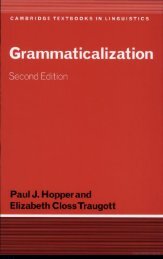What and where? Péter Szigetvári - SEAS
What and where? Péter Szigetvári - SEAS
What and where? Péter Szigetvári - SEAS
You also want an ePaper? Increase the reach of your titles
YUMPU automatically turns print PDFs into web optimized ePapers that Google loves.
(26) Some more Latin–Portuguese correspondences<br />
Latin Portuguese<br />
a. septem sete ‘seven’<br />
b. ventus vento ‘wind’<br />
c. mundus mundo ‘world’<br />
d. porta porta ‘door’<br />
e. carduus cardo ‘thistle’<br />
f. penna pena ‘pen’<br />
g. luna lua ‘moon’<br />
<strong>What</strong> <strong>and</strong> <strong>where</strong>? 123<br />
The cluster analysis <strong>and</strong> the autosegmental representation of geminates – according<br />
to which the first part is empty, cf. (12) – offer a simple explanation for<br />
their resistance to lenition. The second part of the geminate cannot undergo lenition<br />
because it is in a strong, postconsonantal environment, as witnessed by the<br />
fate of the words in (26b)–(26e) – in this historical change Portuguese sonorants<br />
patterned with obstruents in this respect, i.e., any postconsonantal consonant was<br />
in a strong position. The first part cannot undergo lenition because being empty it<br />
has no<strong>where</strong> to simplify, it cannot become less complex. Thus geminate inalterability<br />
does not have to make reference to the double linkage of melodic primes<br />
in such structures (cf. Honeybone 2005), a solution discredited by Inkelas <strong>and</strong><br />
Cho (1993).<br />
Failure to note the cluster status of geminates leads Lass <strong>and</strong> Anderson to treat<br />
“intervocalic” strengthenings like Latin ma[j]or > ma[jj]or ∼ Italian ma[ÃÃ]ore<br />
‘bigger’, Sanskrit dváyōs ∼ Gothic twaddjē, Old Norse tveggja ‘of two’, etc., as<br />
violations of the “preferred” intervocalic change (i.e., lenition) (1975 : 160). The<br />
alleged exceptions cited are not convincing, since they exclusively include geminates.<br />
While we have no explanation for the gemination of the intervocalic glide,<br />
once it occurs the rest of the process is expected: the second part of the geminate<br />
is in a strong (postconsonantal) position, hence a good c<strong>and</strong>idate for undergoing<br />
fortition. The first part of the geminate lenites to zero in weak position, yielding<br />
a strong (plosive) geminate.<br />
This section had two aims. Firstly, to show that it is not evident that degemination<br />
must be treated as a case of lenition, since it shows similarity to cluster<br />
simplification, as well, a process that is not unanimously categorized as lenition.<br />
Secondly, to show that geminate integrity can also be explained by the melodic<br />
emptiness of the first part of a geminate. With such an explanation one does<br />
not encounter the problems that the double-linkage hypothesis entails: it is not<br />
only geminates that exhibit multiple linking of melodic material, yet other such<br />
clusters (homorganic, or sharing laryngeal properites) do not show the degree of<br />
resistence to lenition that geminates do.
















